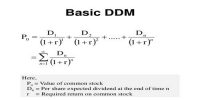The internal rate of return (IRR) is one of the most popular methods of evaluating potential projects. Net Present Value (NPV) is the difference between the present value of cash inflows and the present value of cash outflows. NPV is used in capital budgeting to analyze the profitability of an investment or project.
In many respects, the NPV method is better than IRR. The problem can arise with the IRR method when cost flow patterns are non-conventional. In this comparison between the NPV and IRR, we consider only conventional investments. Even for this group of investments, NPV is a better technique for selecting between mutually exclusive choices because once again problems can arise with the use of the IRR. In many instances, NPV and IRR will give consistent rankings but at times conflicts in rankings between the two, will occur.
Both the tools are majorly used to evaluate the profits from the investments and they both have their own pros and cons. The IRR has to be compared to the discount rate to gauge a project’s feasibility. If the IRR is higher than the discount rate, it’s a good project to pursue. If a project’s NPV is above zero, it’s financially worthwhile.
IRR is the discount rate that equates the present value of the future net cash flows from an investment project with the project initial cash outflow. So,
(a) In the case of non-conventional cash flows there might be multiple IRR, which might give misleading information to the decision maker.
(b) It is difficult to find out and requires more time than any other method.
(c) It assumes that all the internally generated cash flows will be reinvested at the internal rate of return which might not be possible at all.














